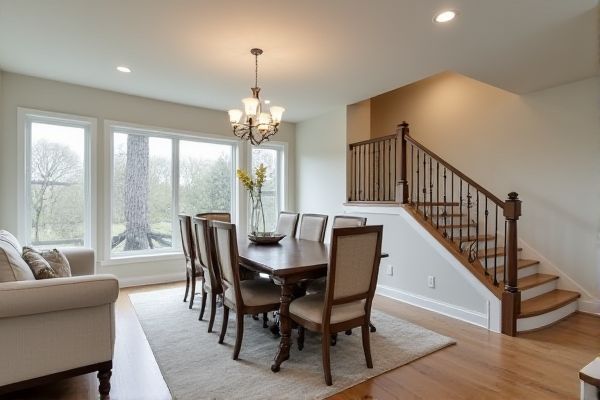
Half-wall railing offers enhanced privacy and safety by creating a solid barrier, while open railing provides a more spacious, airy feel and showcases architectural details. Discover which railing style best suits Your space and design preferences by reading the rest of the article.
Table of Comparison
| Feature | Half-Wall Railing | Open Railing |
|---|---|---|
| Design | Solid half-height wall, provides partial barrier | Typically metal or wood posts and balusters, open view |
| Safety | Higher safety, better for children and pets | Less obstructive but requires secure balusters for safety |
| Visibility | Blocks lower sightlines | Allows clear visibility and light flow |
| Privacy | Provides more privacy | Minimal privacy |
| Maintenance | Requires painting or cleaning solid surfaces | Requires regular cleaning of spindles and posts |
| Cost | Generally higher due to construction materials | Often lower cost or customizable |
| Style | Traditional, sturdy look | Modern, airy appearance |
| Installation | More complex; involves drywall or masonry work | Relatively simpler; mounted posts and rails |
Introduction to Half-Wall and Open Railing
Half-wall railings offer a solid barrier that enhances privacy and safety by partially enclosing staircases or balconies, making them ideal for homes with children or pets. Open railings, featuring balusters or spindles, provide an airy, unobstructed view that visually expands your living space and allows more light to flow through. Choosing between half-wall and open railing depends on your desired balance of openness, safety, and architectural style.
Key Differences Between Half-Wall and Open Railing
Half-wall railing features a solid barrier that provides increased privacy and a sense of separation, while open railing consists of vertical balusters or glass panels that maximize visibility and light flow. Half-wall designs offer greater safety for children and pets by eliminating gaps, whereas open railings enhance aesthetic appeal and maintain openness in your living space. Choosing between these options depends on your priorities for safety, privacy, and visual continuity in your home.
Aesthetic Appeal: Half-Wall vs Open Railing
Half-wall railings offer a solid, continuous surface that creates a sense of privacy and blends seamlessly with interior walls, enhancing a cozy, traditional aesthetic. Open railings, featuring spindles or metal balusters, provide a more airy, modern feel by allowing light and sightlines to flow freely, making spaces appear larger and more connected. Your choice between half-wall and open railing significantly influences the room's visual openness and style, balancing privacy with spatial brightness.
Safety Considerations: Which Option is Safer?
Half-wall railings provide enhanced safety by creating a solid barrier that prevents accidental falls and reduces the risk of small children slipping through gaps, making them ideal for homes with kids or pets. Open railings, while visually appealing and offering unobstructed views, pose higher safety risks due to wider gaps and lower physical barriers, increasing the chance of falls especially on staircases. Your choice should prioritize half-wall railings if safety is a primary concern, particularly in high-traffic areas or homes with vulnerable individuals.
Privacy and Light Flow Comparison
Half-wall railings offer enhanced privacy by providing a solid barrier that partially blocks views, making them ideal for spaces where you want to maintain some separation without fully closing off the area. Open railings maximize light flow and create a more spacious feel, allowing natural light to travel freely while fostering an open atmosphere. Your choice depends on the balance you prefer between visual privacy and the amount of light entering your space.
Cost and Installation Factors
Half-wall railings typically incur higher costs due to the materials and labor required for constructing a solid wall segment, while open railings usually involve less expensive materials such as metal or wood spindles and simpler installation processes. Installation of half-wall railings often demands more extensive structural work and finishing like drywall and painting, increasing both time and expense compared to the straightforward mounting of open railings. Choosing between the two depends on budget constraints and willingness to invest in a more labor-intensive, sturdy design versus a cost-effective, easily installed option.
Maintenance Requirements: Half-Wall vs Open Railing
Half-wall railings require less maintenance than open railings due to their solid structure, which minimizes dust accumulation and damage. Open railings demand frequent cleaning and inspections to ensure safety, as their exposed components are more susceptible to dirt and wear. Your choice should consider how much time and effort you're willing to invest in upkeep to keep the railing looking pristine and secure.
Design Flexibility and Customization
Half-wall railing offers enhanced design flexibility by providing a solid base that can be customized with various materials like wood, stone, or glass, allowing for seamless integration with different interior styles. Open railing provides an airy, minimalist aesthetic with customizable baluster spacing and material options such as metal or cable, ideal for modern or industrial spaces. Both options support tailored design elements, but half-wall railing gives more privacy and structural versatility, while open railing maximizes light flow and visual openness.
Pros and Cons of Half-Wall Railings
Half-wall railings offer increased privacy and safety by providing a solid barrier that can prevent falls and reduce noise transmission, making them ideal for households with children or pets. However, their design can obstruct sightlines and limit light flow compared to open railings, potentially making spaces feel smaller and less connected. Maintenance may also be higher due to the need for wall painting or repairs, whereas open railings often require minimal upkeep.
Pros and Cons of Open Railings
Open railings offer an unobstructed view that enhances natural light distribution and creates a spacious atmosphere, making them ideal for modern and minimalist interiors. They provide less visual barrier compared to half-wall railings, promoting better air circulation and a seamless connection between spaces. However, open railings may lack privacy and pose safety concerns for young children or pets, requiring careful material selection and installation to ensure durability and security.
 homyna.com
homyna.com